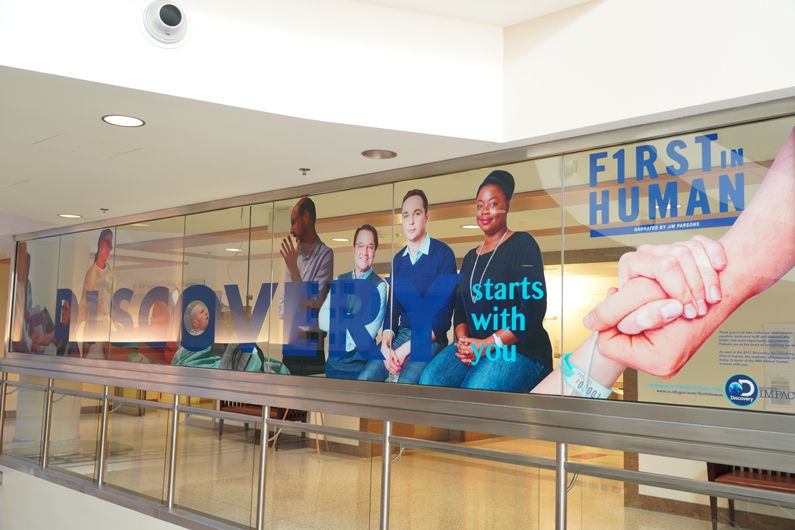What has been discovered since Discovery's First in Human TV series?

In honor of the third anniversary of Discovery's First in Human documentary series (August 2020), CC News contacted the research teams who were featured on the program to ask "What has been discovered since Discovery?" The three-part television show, which began pre-production filming in September 2015, captured the real-life experiences of doctors, researchers, staff, patients and their caregivers, at the Clinical Center and captured the challenges faced in diagnosing and treating disease.
Since filming began, some researchers have hit incremental scientific milestones, and for others, there have been major breakthroughs. Here's what they had to say:
Jobs Syndrome Research
Dr. Alexandra Freeman, an Immunologist with the Primary Immune Deficiency Clinic at the National Institute of Allergy and Infectious Diseases, said that "since First-In-Human, we have done a bone marrow transplant with three patients with Job's syndrome (Autosomal dominant Hyper IgE syndrome), which is the condition for which Lucy [Wiese] had a transplant. All three have done quite well and have had better health since transplant. We have plans for more transplants in this patient population in the upcoming year."
She also shared that "from the bench science work, we have collaborated with Dr. Manfred Boehm's group in the NIH National Heart, Lung, and Blood Institute and have found some clues into the reasons behind the poor wound healing for these patients, to help us explain in part why patients like Lucy have such big cavities in their lungs that go on to cause so many problems."
By coordinating with Boehm's lab, Freeman said they have found that the formation of new blood vessels is impaired, as well as how some proteins help to start the healing process.
"We are hoping these breakthroughs help lead the way to come up with more therapies to help prevent the severe lung damage these patients experience as well as other complications, such as aneurysms in blood vessels."
View recently published research: https://pubmed.ncbi.nlm.nih.gov/32369445/, https://pubmed.ncbi.nlm.nih.gov/31493539/, https://pubmed.ncbi.nlm.nih.gov/32696285/
Melanoma Research
Dr. Stephanie Goff, an Associate Research Physician in the Surgery Branch of the National Cancer Institute said "the work that Anita [McAllister] contributed to the most is still an active area of investigation. She was the first of many patients with melanoma where we tried to do a deeper investigation into mutation reactivity. The lab responsible for that has now analyzed close to 40 patients, and the work will be published soon."
Goff added that they are in progress on "writing our larger melanoma experience" but did publish the results of a randomized trial evaluating tumor infiltrating lymphocytes for melanoma in 2016. Separately, they also published a manuscript in 2018 describing the clinical case of a breast cancer patient who was mentioned in the closing of the First in Human series.
Leukemia Research
Not long after First in Human aired, Dr. Terry Fry, a research oncologist who cared for patient Bo Cooper, left the NIH to join Children's Hospital Colorado as co-director of the human immunology and immunotherapy initiative.
A collaborator of Fry's, Dr. Nirali Shah, Head of the Hematologic Malignancies Section in the Pediatric Oncology Branch at the National Cancer Institute, continues to spearhead the CAR T-cell therapy.
Shah said "our CD22 CAR trial received FDA Breakthrough therapy designation in 2019." In addition, Shah said they have a new CAR T-cell trial targeting CD33 for acute myeloid leukemia.
"One new area of research is in looking at late effects/sub acute toxicities of CAR T-cells and we recently hosted a conference (virtual)," Shah added. View the conference.
Sickle Cell Research
Dr. John Tisdale, a Senior Investigator in the Cellular and Molecular Therapeutics Branch at the National Heart, Lung and Blood Institute says, "there have been a number of advances since [First in Human]." As a part of Tisdale's clinical trial, patient Deidra Flowers-Williams received a stem cell transplant and had profound benefits – free of sickle cell pain.
"We have shown that we can extend the transplant approach from matched donors as in the documentary, to half-matched donors and Dr. Courtney Fitzhugh now has very high success rates even with half-matched donors," Tisdale said. "With this approach, almost everyone has a donor since a biological parent or a child is always a half match, and half of full siblings are half matches."
In addition, he said that his team has moved on with gene therapy using the patient's own cells instead of a donor.
"With this, we transfer a correctly spelled gene using a vector based upon HIV in a flask, then transplant these cells back to the patient. This was featured in a CBS 60 Minutes segment. We have published an improved vector based upon HIV recently that is even better than the one in the trial. The first patients on this trial had only modest benefit, so we worked to improve things. We found that the bone marrow was problematic and published that, and moved to collecting the cells from the blood instead and published that. It works much better. We also improved the method for transferring the gene and published that. Now it is working well, and we are almost done with the initial trial. We will be publishing the first set of patients soon, then we will publish the full results with the improvements after."
In regards to gene editing, Tisdale has published a method for using CRISPR to edit a gene that turns off the hemoglobin made in utero called fetal hemoglobin once someone is born. If they edit that gene in bone marrow cells, the patient stops making adult hemoglobin (which is the sickle hemoglobin in sickle cell disease), and the patient starts making the fetal hemoglobin again, which doesn't sickle and otherwise works fine as a hemoglobin. An external company is now working on that trial, "which looks encouraging" Tisdale said.
Finally, NIH launched the Cure Sickle Cell Initiative to accelerate the development of genetic therapies to cure sickle cell disease.
- Molly Freimuth